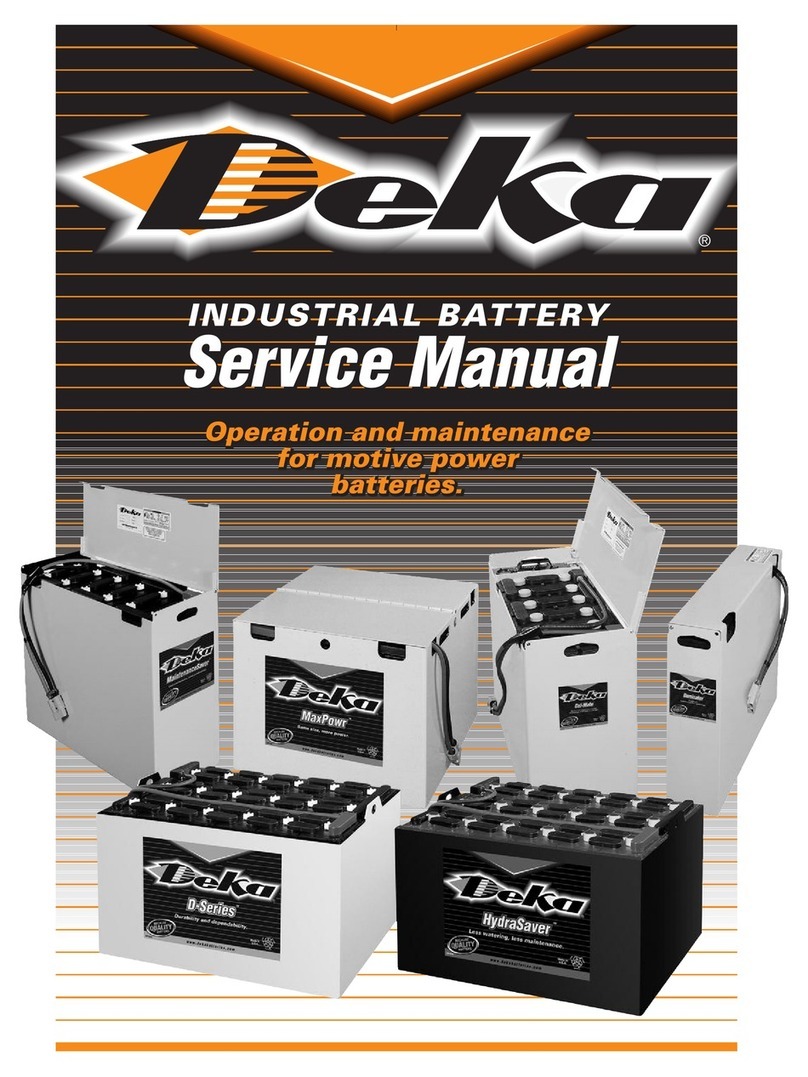Deka unigy User manual

HIGH RATE SERIES
STATIONARY BATTERY INSTALLATION
AND OPERATING INSTRUCTIONS
DANGER
!
SHIELD EYES
EXPLOSIVE GASES
CAN CAUSE BLINDNESS
OR INJURY.
NO.
•
SPARKS
•
FLAMES
•
SMOKING
SULFURIC
ACID
CAN CAUSE
BLINDNESS OR
SEVERE BURNS.
FLUSH EYES
IMMEDIATELY
WITH WATER.
GET
MEDICAL
HELP
FAST.
HIGH
VOLTAGE...
RISK OF SHOCK.
DO NOT TOUCH
UNINSULATED
TERMINALS OR
CONNECTORS.
DO NOT REMOVE VENT VALVE.
WARRANTY VOID IF VENT VALVE IS REMOVED.
VENTILATE WELL WHEN IN AN ENCLOSED
SPACE AND WHEN CHARGING.
REPAIR SHOULD BE PERFORMED ONLY
.BY A QUALIFIED SERVICE TECHNICIAN.
SEE INSTALLATION, MAINTENANCE AND OPERATION
INSTRUCTIONS FOR IMPORTANT SAFETY PRECAUTIONS.
SAFETY PRECAUTIONS
Although all valve-regulated batteries have the elec-
trolyte immobilized within the cell, the electrical hazard
associated with batteries still exists. Work performed on
these batteries should be done with the tools and the
protective equipment listed below. Valve-regulated
battery installations should be supervised by personnel
familiar with batteries and battery safety precautions.
Protective Equipment
To assure safe battery handling, installation and
maintenance, the following protective equipment
should be available:
1. Safety glasses or face shields
2. Acid-resistant gloves
3. Protective aprons
4. Lifting devices
5. Use only insulated tools.
Procedures
The following safety procedures should be followed
during installation: (Always wear safety glasses or
face shield.)
1. Adequately secure battery racks or cabinet
enclosures to the floor.
2. Connect support structures to ground system in
accordance with applicable codes.
3. Inspect all flooring and lifting equipment for functional
adequacy. Specifically review floor loading capacity.
4 Prohibit smoking and open flames, and avoid
arcing in the immediate vicinity of the battery.
5. Keep the top of the battery clear of all tools
and other foreign objects.
6. Provide adequate ventilation and follow
recommended charging voltages.
7. Avoid wearing metallic objects such as
jewelry while working on the battery.
8. Never remove or tamper with the pressure relief valves.
9. These batteries are sealed and contain no free
electrolyte. Under normal operating conditions they
do not present any acid danger. However, if the
battery case or cover is damaged, acid could be
present. Sulfuric acid is harmful to the skin and
eyes. Flush affected area with water immediately
and consult a physician if splashed in the eyes.
10. Extinguishing media: Class ABC extinguisher.
Note: CO2 may be used. The thermal shock may
cause the case to crack.
Battery posts, terminals and related
accessories contain lead and lead
compounds, and other chemicals
known to the state of California to
cause cancer and birth defects or
other reproductive harm.
Wash hands after handling.
California
Proposition 65 Warning

RECEIVING
AND STORAGE
Receiving Inspection
Upon receipt, and at the time of actual unloading,
each package should be visually inspected for any
possible damage or electrolyte leakage. If either is
evident, a more detailed inspection of the entire
shipment should be conducted and noted on the
bill of lading. Record receipt date, inspection data
and notify carrier of any damage.
Unpacking
(Always wear eye protection.)
1. Never lift batteries by the terminal posts. Always lift
batteries by the bottom or use the lifting handle.
2. Check all batteries for visible defects such as
cracked containers, loose terminal posts, or other
unrepairable problems. Batteries with these defects
must be replaced.
Storage
1. Cells should be stored indoors in a clean, level, dry
and cool location. Recommended storage tempera-
tures are 0°F to 90°F (–18°C to 32°C).
2. Lead acid batteries self-discharge and must be given
a boost charge periodically to prevent permanent
performance degradation. Batteries should not be
stored for more than 180 days without applying a
boost charge of 13.8 volts ± .06 volts per battery
until the current stabilizes. Record dates and condi-
tions for all charges during storage.
INSTALLATIONS
Cabinets
Cabinet systems come factory assembled and
prewired. Do not tip or turn cabinets on their sides
when positioning them in their intended installation
area. Cabinets must be used in an upright position.
These systems are preconnected. Only inter-shelf,
inter-cabinet and connections to the load are
required. See the connection diagram inside the
cabinet. Inter-cabinet and load connection cables
are not included.
Racks
Assemble racks in accordance with the intended
arrangement, align with a level and bolt to the floor.
See rack assembly instructions.
BATTERY
ASSEMBLY
(Always wear eye protection.)
1. Set up the batteries so that the positive post (+) of one battery
is connected to the negative post (–) of the next battery for
all series connections. Make sure they match the connection
diagram. For parallel or parallel/series combinations, check
the connection diagram.
2. The intercell connection contact surfaces should be cleaned
by rubbing gently with a non-metallic brush or pad before
installing connectors.
3. Install all intercell connections loosely to allow for final
alignment of batteries, then torque to 60± 5 inch pounds.
General
1. Install the lockwasher and torque the terminal bolts or nuts
to 60 ± 5 inch pounds. DO NOT OVERTORQUE. Some
batteries have cable harnesses (torque value is 60 ± 5).
2. Clean all outside surfaces of batteries, cabinets and
racks with soapy water only. DO NOT USE SOLVENTS.
3. For future identification of all racked batteries, apply
individual battery numbers in sequence beginning with
number one at the positive end of the first battery.
4. After torquing the connections on racked batteries, read the
voltage of the battery string to assure that individual batteries are
connected correctly. The total voltage should be approximately
equal to the number of batteries times the measured voltage of
one battery (when connected in series). If the measurement is
less, recheck the connections for proper voltage and polarity.
5. Read and record intercell connection resistance and note
the method of measurement. This helps determine a
satisfactory initial installation and can be used as a reference
for future maintenance requirements. See Appendix A,
recording forms, in the back of the manual. Clean, remake
and remeasure any connection having a resistance
measurement greater than 10% of the average of all the
same type of connections (intercell, inter-tier or shelf,
inter-rack or inter-cabinet).
6. Battery performance is based on the output at the battery
terminals. Therefore, the shortest electrical connections
between the battery system and the operating equipment r
result in maximum total system performance.
Do not select cable size on current carrying capabilities
only Cable size should not provide a greater voltage drop
between the battery system and operating equipment than
specified. Excess voltage drop will reduce the desired
support time of the battery system. Cables are not
recommended for connecting parallel battery strings.
HIGH RATE SERIES

7. When paralleling valve-regulated batteries, the capacity,
arrangement and external circuit length should be
identical for each battery string because a wide variation
in battery circuit resistance can result in unbalanced
charging (i.e., excessive charging currents in some
batteries, and undercharging in others). As a conse-
quence, a single battery failure in one battery string
and the subsequent loss of performance capabilities
of that string, will result in higher loads in the other
parallel string(s), which may exceed the ratings of the
battery connections. This can damage the battery
system and dramatically shorten battery life.
SYSTEM
OPERATION
These batteries are designed for continuous float
application. The charger must be able to sustain the
system voltage within ± .01 volts per cell of the desired
level at all times. The desired float voltage varies with
temperature according to the table below.
Equalizing
Upon installation of the high rate battery series, an
optional boost charge of 13.80 volts ± .06 volts for a
maximum of 24 hours can be applied.
If this is done, be sure to reset the charging equipment
to the proper float voltage. The average battery
operating temperature should not exceed 95°F (35°C)
and should never exceed 105°F (40.5°C) for more than
an eight-hour period.
Operating at temperatures greater than 77°F (25°C)
will reduce the operating life of the battery. If operating
temperatures are expected to be in excess of 95°F
(35°C), contact East Penn for recommendations.
Battery Battery High Rate
Temperature Temperature Per Battery Float Voltage
Degrees F Degrees C ± .06 volts
50° . . . . . . . . 10° . . . . . . . . . . . . . . . . . 13.50
59° . . . . . . . . 15° . . . . . . . . . . . . . . . . . 13.50
68° . . . . . . . . 20° . . . . . . . . . . . . . . . . . 13.50
77° . . . . . . . . 25° . . . . . . . . . . . . . . . . . 13.50
86° . . . . . . . . 30° . . . . . . . . . . . . . . . . . 13.50
95° . . . . . . . . 35° . . . . . . . . . . . . . . . . . 13.38
PERIODIC
MAINTENANCE
(Always wear eye protection;
keep sparks and flames away.)
Annual Inspection
1. Conduct a visual inspection of the battery(ies).
2. Record the battery string voltage.
3. Record the charger voltage.
4. Record the individual battery voltages.
Batteries should be within ± 0.18 volts of float voltage.
5. Record the ambient temperatures.
6. Record all inter-battery and terminal connections.
Micro-ohm readings should be taken during this
inspection. If any reading differs by more than 20%
from the inital reading taken, retorque the connection
to 60 ± 5 inch-pounds. Recheck the micro-ohm reading.
If the reading remains high, clean the contact surfaces
according to Step 2 under Battery Assembly.
Capacity Testing
Capacity tests may be run if operation is questionable.
Do not discharge the batteries beyond the specified
final voltage. Record all findings.
Should it be determined that any individual battery
need be replaced, contact your nearest Unigy I agent
or East Penn Service Center.
BATTERIES
AND RELATED PARTS
CONTAIN LEAD
California Proposition 65 Workplace Warning Sign 1/99
Must be posted in workplace near batteries.
WASH HANDS
AFTER HANDLING !
CALIFORNIA PROPOSITION 65 WARNING:
Battery posts, terminals and related accessories
contain lead and lead compounds, and other
chemicals known to the State of California to cause
cancer and birth defects or other reproductive harm.

APPENDIX A
Lyon Station, PA 19536-0147 • Phone: 610-682-6361 • Fax: 610-682-4781
Order Department Hotline: 610-682-4231
DISTRIBUTED BY:
E.P.M. Form No. 0970 Rev. 1/02 © 2002 by EPM Printed in U.S.A.
Charger Output ____________________Amp Air Temperature____________________°F
Total Battery String Voltage _______________ Panel Meter Volts ____________________
Year _______________________ Year _______________________ Year _______________________ Year _______________________
Unit Ohms or Unit Ohms or Unit Ohms or Unit Ohms or
Number Volts Mhos Number Volts Mhos Number Volts Mhos Number Volts Mhos
Inspection Date_______________________________________________________________ No. of Units/String _________________
Company ___________________________________________________________________ Type ____________________________
Address ____________________________________________________________________ Date New ________________________
Battery location and/or number __________________________________________________ Date Installed_____________________
Readings Taken By ____________________________ Remarks/Recommendations __________________________________________________________
Readings should be taken at installation and annually thereafter. _________________________________________________________________________________
1111
2222
3333
4444
5555
6666
7777
8888
9999
10 10 10 10
11 11 11 11
12 12 12 12
13 13 13 13
14 14 14 14
15 15 15 15
16 16 16 16
17 17 17 17
18 18 18 18
19 19 19 19
20 20 20 20
21 21 21 21
22 22 22 22
23 23 23 23
24 24 24 24
25 25 25 25
26 26 26 26
27 27 27 27
28 28 28 28
29 29 29 29
30 30 30 30
31 31 31 31
32 32 32 32
33 33 33 33
34 34 34 34
35 35 35 35
36 36 36 36
37 37 37 37
38 38 38 38
39 39 39 39
40 40 40 40
Avg. Voltage Avg. Voltage Avg. Voltage Avg. Voltage
Individual
Battery Readings
BATTERY MAINTENANCE REPORT
Other Deka Camera Accessories manuals
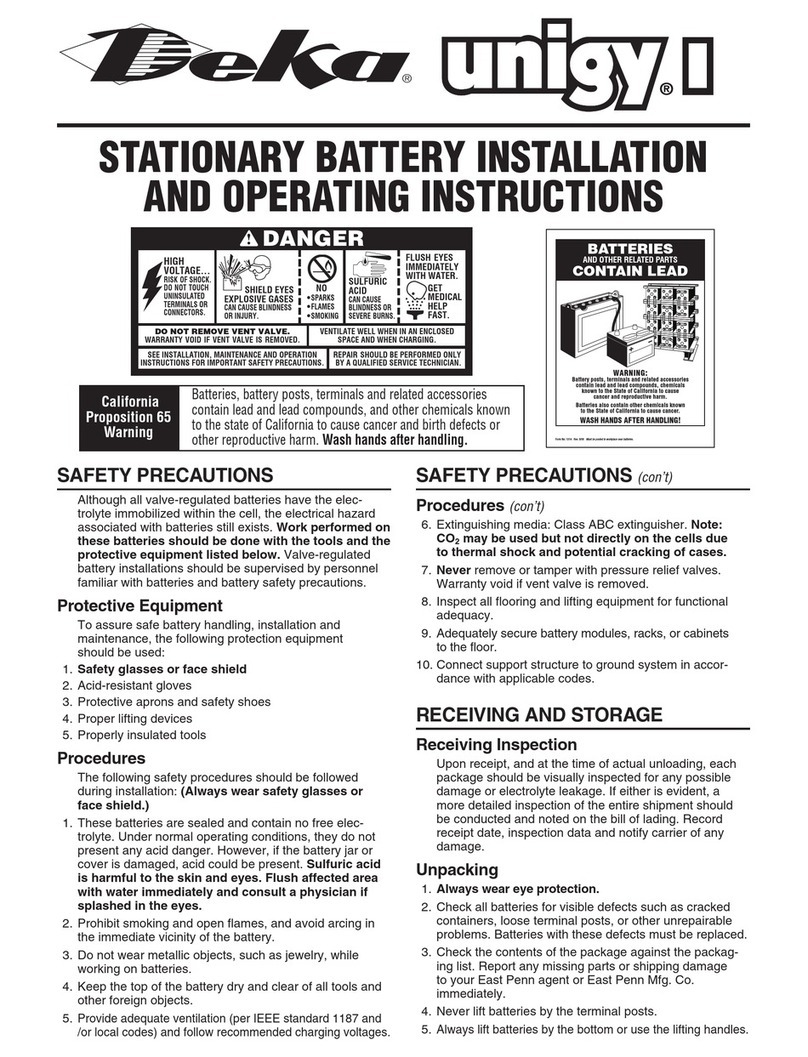
Deka
Deka unigy I User manual

Deka
Deka Unigy I User manual
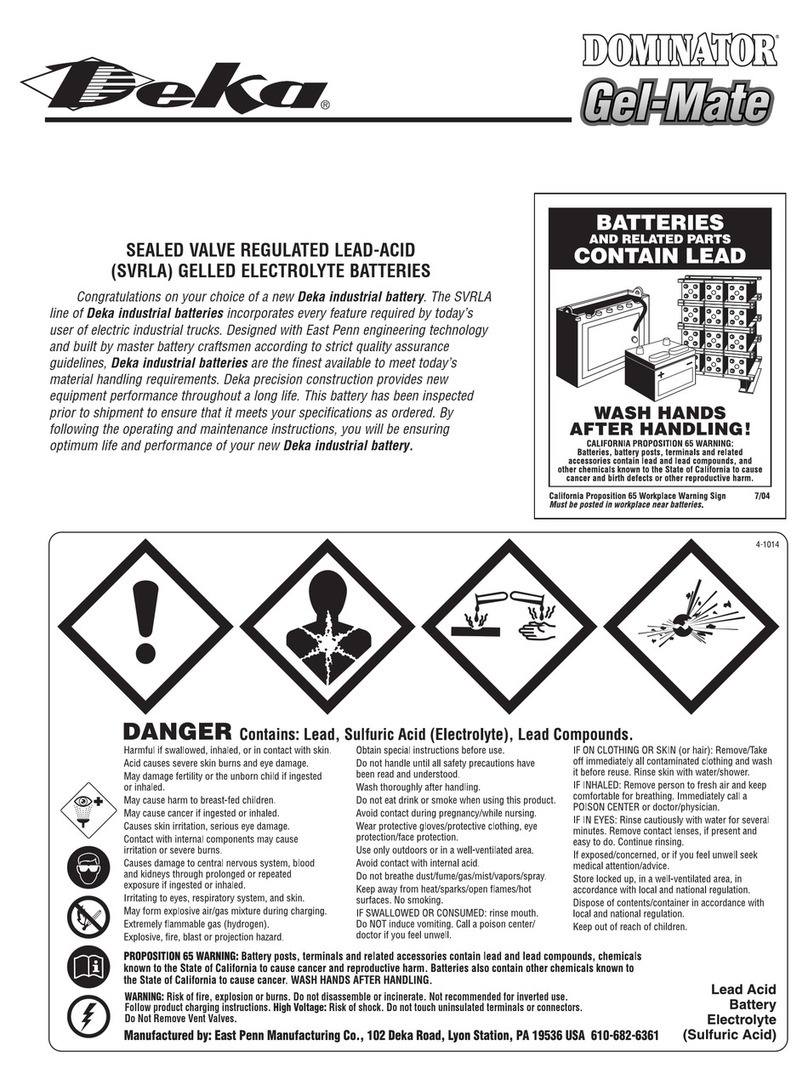
Deka
Deka Dominator Gel-Mate SVRLA G105 User manual

Deka
Deka unigy II SPACESAVER Non-Interlock AVR 45 AH User manual

Deka
Deka Unigy II User manual

Deka
Deka Unigy II AVR45 Series User manual

Deka
Deka FastCharge F35 User manual
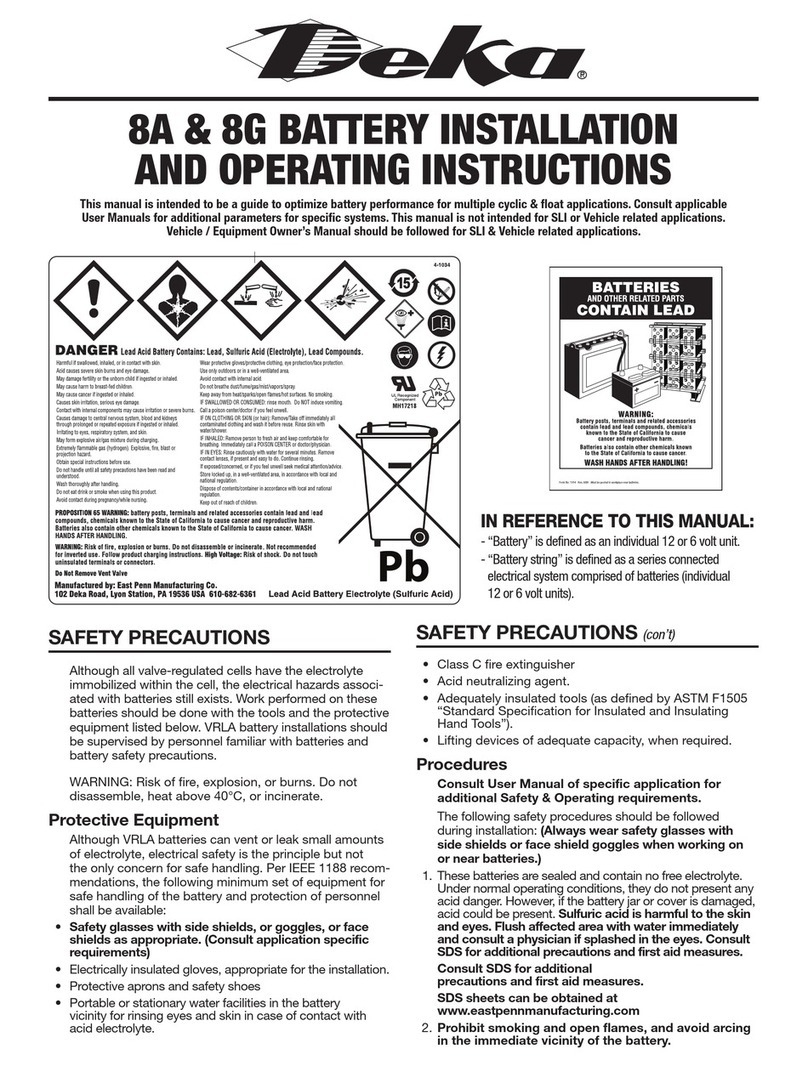
Deka
Deka 8A User manual
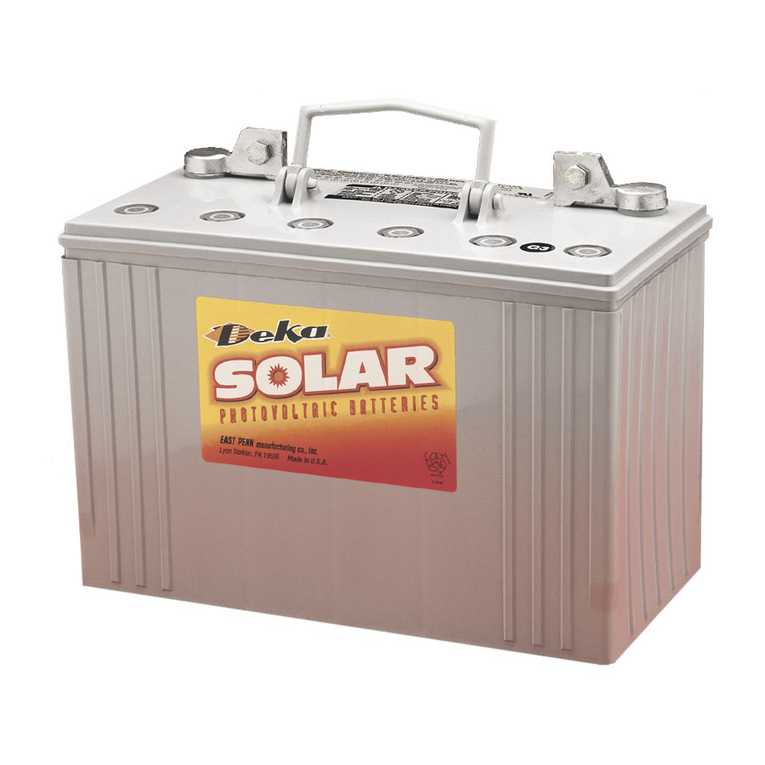
Deka
Deka SOLAR Monoblock VRLA System Installation instructions
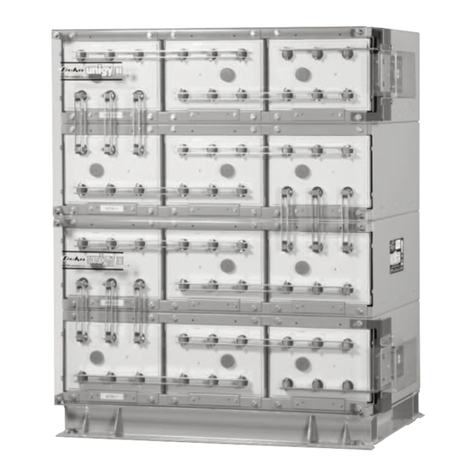
Deka
Deka Unigy II User manual
Popular Camera Accessories manuals by other brands

Trojan
Trojan GC2 48V quick start guide

Calumet
Calumet 7100 Series CK7114 operating instructions

Ropox
Ropox 4Single Series User manual and installation instructions

Cambo
Cambo Wide DS Digital Series Main operating instructions

Samsung
Samsung SHG-120 Specification sheet

Ryobi
Ryobi BPL-1820 Owner's operating manual
